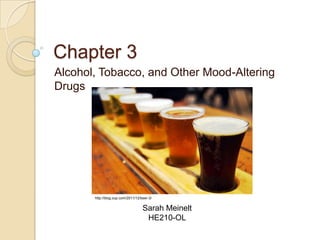
Chapter 3: Alcohol, Tobacco, and Other Mood-Altering Drugs
- 1. Chapter 3 Alcohol, Tobacco, and Other Mood-Altering Drugs http://blog.oup.com/2011/12/beer-3/ Sarah Meinelt HE210-OL
- 2. Drugs Women and Girls Use: The Stats Alcohol- most common drug used by women; 45% of women over the age of 12 Tobacco- 21% of women smoke Mood-Altering Prescription Drugs- includes drugs such as pain relievers, sedatives, stimulants, and tranquilizers. Approximately 3% of women over age 12 have reported using them for nonmedical reasons. (2002 survey) Illegal Drugs- 6% of women in the US over age 12 were current users of illegal drugs in 2002; most common: Marijuana
- 3. How Substance Abuse Affects Our Health: Alcohol Can diminish: motor coordination, judgment, emotional control, and reasoning power Can disrupt normal menstrual cycles Increases risk of: mouth, esophageal, and liver cancer, major depression, epilepsy, hemorrhagic stroke, and cirrhosis of the liver Other risks: hypertension, osteoporosis, breast cancer, gastric ulcers, and alcohol hepatitis Drinking during pregnancy can cause permanent birth defects and developmental disabilities
- 4. How Substance Abuse Affects Our Health: Tobacco Approximately 178,000 US women die from smoking-related diseases each year Smokers are twice as likely to have heart attacks and strokes Smoking causes 90% of all lung cancer deaths and lung diseases Smoking increases risk of cervical cancer Women who smoke may have more difficulty getting pregnant, have more period problems, and go into menopause earlier Smoking during pregnancy can pass chemicals to the fetus- newborns in homes of smokers are more likely to die of sudden infant death syndrome
- 5. Secondhand Smoke Exposure to secondhand smoke is very dangerous and poses a health hazard Regular exposure can cause lung and heart disease including: lung cancer in adults, pneumonia, bronchitis, asthma, and chronic ear infections in children www.sacramentorealestatelawyerblog .com/2011/09/lease-goes-up-in- smoke.html Approximately 36,000 women die each year due to secondhand smoke exposure
- 6. How Substance Abuse Affects Our Health: Tranquilizers Tranquilizers are commonly prescribed for short-term relief of anxiety, sleeping problems, and withdrawal from other drugs Can be highly addictive, even at standard doses Withdrawal symptoms: increased anxiety and panic attacks, flu-like symptoms, hypersensitivity to light, depression, dizziness, weakness, tremors, heart palpitations, sweating, nausea, indigestion, bodily pains Coming off the drug: consider tapering
- 7. How Substance Abuse Affects Our Health: Ecstasy Ecstasy is a synthetic combination drug that has both stimulant and hallucinogenic effects- can have positive relaxing and social effects Use in settings such as raves can cause severe dehydration, heat exhaustion, and liver malfunction http://www.562citylife.com/profiles/blogs/the-long-beach-rave-scen Short term effects: paranoia, anxiety, depression Long term effects: impairment in mental function and memory Women are more sensitive to the effects of Ecstasy than men- more intense perceptual changes and more long-term affects http://hometestingblog.testcountry.com/?p=8964
- 8. Influences on Use- Why do we still use these substances? Promotion- companies try to make us think that these substances will bring us health, happiness, success, sophistication, and freedom Personal and Social Pressures- organize social relationships, carve out time for ourselves, control our emotions, create an image, source of comfort and dependability Addiction- may be afraid or not know how to stop, don’t know where to get help, many women deny they have a problem, women can be ashamed of the consequences of their use leading them to be immobile
- 9. Promotions- Targeting Women Women have specifically been targeted by tobacco companies 1960s and 1970s- ads equated smoking with independence, sophistication, a nd beauty. Brands called “thins” and “slims” played into social pressures for women to control weight 1970s- “low tar” or “light” cigarettes: all a myth to get women to maintain their addiction and prevent them from quitting Recent years- themes of rebelliousness http://tobaccocontrol.bmj.com/content/11/suppl_1/i18.full
- 10. Reducing the Risks General Guidelines: ◦ Tobacco - no level of use is safe ◦ Alcohol - have no more than one drink a day ◦ Do not drink: if you are pregnant or breastfeeding, before you drive, if you are taking medication that reacts negatively with alcohol, if you have medical problems that get worse with drinking, if you have addiction problems Know the drugs you are taking Don’t take drugs at parties or clubs Don’t mix drugs Know your body’s limits and reactions Never share needles Be aware of how your choices may influence other areas of your life Find other ways to reduce stress, cope with life, and have fun
- 11. Finding Help Quitting Smoking: ◦ Go “Cold turkey” ◦ Use self-help materials available online ◦ Attend classes or support groups ◦ Call “quit lines” ◦ Receive counseling from health care providers ◦ Take medication: nicotine replacement, prescription nasal inhaler or spray, antidepressants There is no right or wrong method- assistance increases the chances of success Self-help groups (i.e. Alcoholics Anonymous) Over 2 million Americans, ages 12+, receive some kind of special care each year for substance abuse (another 20 million people probably need it)
- 12. Working Together- Prevention, Treatment, and Policy Drug Policy Alliance- leading US organization working toward “new drug policies based on science, compassion, health, and human rights” A number of policies have improved public health and reduced smoking Health providers have been working to develop trauma, mental health, and substance use programs based on women’s needs
- 13. Quote “I’ve been a waitress for forty years to earn a decent living for my daughter and myself. My doctor told me I had a smoker’s tumor, and therefore I’m dying. I never smoked a day in my life.” pg. 48
- 14. Discussion Question Have you put yourself in a dangerous situation involving drugs or alcohol and realized after the fact that you need to make a change? What led you to finally decide to make that change? How did you go about making that change?